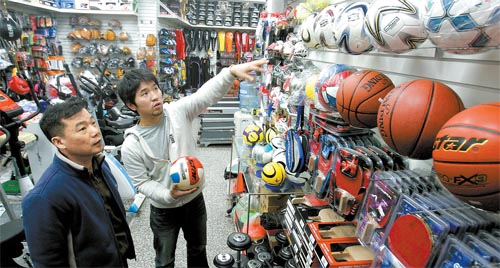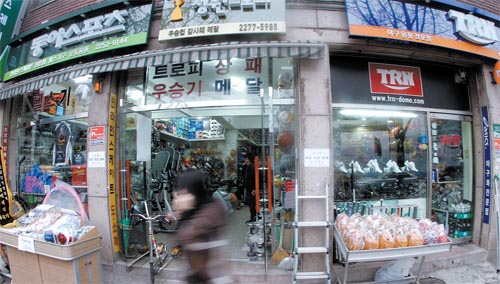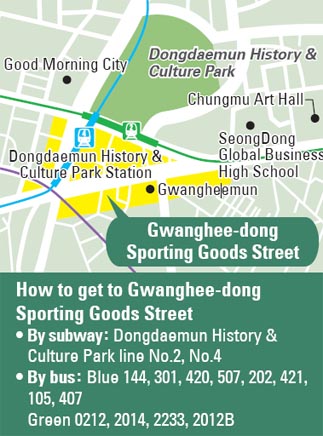Sporting goods stores still thrive near former stadium site

A customer checks out soccer balls on a rack at Donga Sports in Gwanghee-dong, near the site where Dongdaemun Stadium once stood.
You can find roughly 100 or so of these stores lining the main streets leading to Dongdaemun - which ranks as Seoul’s fashion center - in addition to the area near Hanyang Technical High School.
The stores here sell a broad array of sporting equipment, from treadmills, weights and soccer balls to tennis and badminton racquets, bowling balls and hula hoops as well as uniforms, shoes, taekwondo outfits and other types of sports-related clothing.
The only items largely absent: those related to leisurely outdoor activities such as cycling, mountain climbing as well as water sports like rafting and scuba diving. There’s also just one golf shop.
If you’re in the market for anything else sports-related, though, you’ll likely find it here.
Customers can even get assistance with old sports equipment and technology.
“If you have a broken treadmill that is no longer manufactured, some of the stores here can find the parts or help you fix the equipment, which is a service one cannot find outside of this neighborhood,” said Kang Suk-yong, president of Woori Sporting Goods, which is located near the site of the former stadium.
Batter up
On a recent Friday afternoon, Kang Min-soo, 37, and his friend visited a sporting goods store in the Gwanghee-dong neighborhood while hunting for a baseball mitt.
“I’ve recently joined a baseball team,” Kang said. “My friend, who joined the same team earlier than I did, told me that this was the neighborhood to come to for high-quality mitts.”
Koo Nari, president of Daesung Sports, said the company has seen a sharp increase in customers like Kang over the last year. He attributes it in large part to the baseball fever that’s been sweeping the nation ever since the Beijing Olympics in 2008, when Korea won the gold medal.
“Also, with the Korean national team finishing as the runner-up in the World Baseball Classics earlier this year, adults and children alike are joining neighborhood baseball teams and little leagues,” Koo said. “Sales have gone up 20 to 30 percent compared to previous years.”
Some stores did in fact relocate to other areas after the demolition of the stadium last year.
Around 20 sporting goods businesses, for instance, relocated to the Jamsil Sports Complex.
Yet many of the stores in existence for several decades simply moved to new buildings in the same area.

Numerous stores in this area sell sporting goods ranging from baseball and soccer equipment to treadmills. By Jeon Min-gyu
Choi added that stores like Samsung Sports, which has been in business next to the Dongdaemun Stadium site for 30 years, have difficulty moving because of their regular customers.
Kang of Woori Sporting Goods, which is one of the many sports equipment stores that was once located inside Dongdaemun Stadium, said some of the stores have been run by three generations. Kang himself took over the family business, as Woori was founded by his father.
“Back in the 1960s there were only 40 or 50 sports equipment stores,” he recalled.
Kang said sports equipment stores really started to mushroom in the neighborhood in the early 1980s - when Korea hosted the Asian Games - and then again with the Olympics in 1988.
“Before the 1980s people mostly watched these sports, but after the 1980s more people started to participate in them by joining neighborhood soccer and baseball teams,” Kang said.
“With the nation’s economy booming and with more money to spend, people started to take an interest in improving their quality of life through sports and leisure while taking more overall notice of their personal health.”

Long before the Jamsil Sport Complex opened to the public in 1984, Dongdaemun Stadium was the nation’s center of sports. Built during the Japanese colonial period in 1926, the stadium hosted various sporting events, focusing in particular on soccer and baseball games. But the facility became outdated over time and the more modern Jamsil Stadium became the preferred venue. The soccer field was eventually transformed into a parking lot and even served as a market for various fashion items. The baseball field continued to host small sports events, including amateur competitions, but completely closed down in 2008.
Tight-knit community
Although many of them are competitors, the stores make up a tight-knit community that forms a strong network in the industry. That’s changed a bit over the past year, however.
Since the stadium was demolished and stores spread out to different buildings, the network and communication among the remaining shops has eroded a little, Kang said.
“When we had Dongdaemun Stadium, many of the stores were clustered around it, so it was easy for us to provide a one-stop service,” Kang said. “If my store didn’t have an item or a part that a customer was looking for, the customer could visit the store next door.
“But now with stores located in different buildings and more spread out, it’s become less convenient than when we were grouped in the same location.”
Still, a huge strength of the sporting goods stores lies in their expertise.
“Many of the people working here are former athletes, and they can provide in-depth information on sports equipment,” Choi of Samsung Sports said.
That’s one of the reasons, Choi said, that people still trek to this area despite the fact that they can get sports equipment at retail stores closer to home like E-Mart.
“The customers have a limited choice at those retail stores, and most of the equipment is low-quality. They also aren’t able to receive professional opinions, which they can get here, even when buying a Ping-Pong paddle,” Choi said.
Even better for consumers: the retail price of sporting goods here are, on average, 10 percent less than other areas, business owners in the neighborhood say.
By Lee Ho-jeong [ojlee82@joongang.co.kr]










with the Korea JoongAng Daily
To write comments, please log in to one of the accounts.
Standards Board Policy (0/250자)